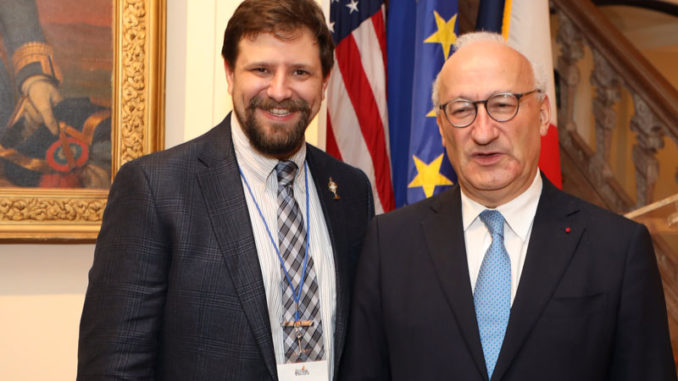
COLUMBIA—Ben Jett, a teacher at Cardinal Newman School, gained valuable insight into the human spirit at the Eileen Ludwig Greenland National Bearing Witness Summer Institute.
Jett was among 40 educators chosen for an intensive look at Jewish-Catholic relations and discussions on how to teach the Holocaust to a new generation.
The annual conference is co-sponsored by the Anti-Defamation League, the United States Council of Catholic Bishops, the United States Holocaust Memorial Museum, Georgetown University Center for Jewish Civilization, the National Catholic Education Association, and the Archdiocese of Washington.
Read Jett’s article below:
Although there were many incredible moments during the week, from visiting the USCCB and hearing Archbishop Gregory speak to attending a reception at the French ambassador’s residence, for me the most impactful day of the institute was the day we were able to visit the Holocaust memorial and hear a testimony from one of the few survivors still living today, Halina Peabody.
I had been to the memorial once before, but this time I was able to take my time wandering through the exhibits studying the myriad of pictures and articles and really start to humanize the often-cited number of six million Jews plus millions of other political prisoners. Many of us only see pictures of the concentration camps or photos of the dead, but the memorial helps us focus on who the people were before the war, showing them in their everyday lives: smiling, playing, dancing, and singing — a vibrant Jewish culture.
One of the things that struck me most as I moved through the exhibit was a rusty milk can. Known as the Ringelblum milk can, it is one of three that were buried in the Warsaw ghetto before its destruction in 1943. The cans were filled with diaries, papers, and posters that were meant to be found after the war ended. Although the people had no illusions about their own survival, they had hope that this was not the end for their people, and that the jugs would someday provide a witness of what happened in Poland. Among so much sadness and despair, this stood as a sign of hope for a future, even as they faced their own deaths.
We were also fortunate to hear the story of Halina Peabody, who was 7 years old at the start of the war. She told the story of her parents’ courage living as Jews in Poland. Her father was deported to Siberia and her mother was able to procure Baptism papers for them all and hide in plain sight, even working for the German officers as a way to help keep their identities a secret. Halina’s story has a happy ending as both of her parents survived the war, and they were able to reunite after the liberation of Poland. She told the story with such mirth and forgiveness in her heart that it was hard not to be invested in her story and in her personally. Halina’s is just one of many stories for us to share and experience. It is fortunate for us today that the Shoah Foundation set out to collect many of these stories on video before the survivors died, and today there are thousands of hours of eyewitness testimonies available to us all.
The thing that will stick with me the most after spending an intensive week looking into the darkness that humanity can become is that no matter how dark things get, how terrible the acts of mankind to one other become, that none of that darkness can stamp out the light that is the human spirit. The Bearing Witness Institute reminded all of the teachers present of our important role in passing on that light so that we can ensure that the great atrocities of history will not be repeated.

